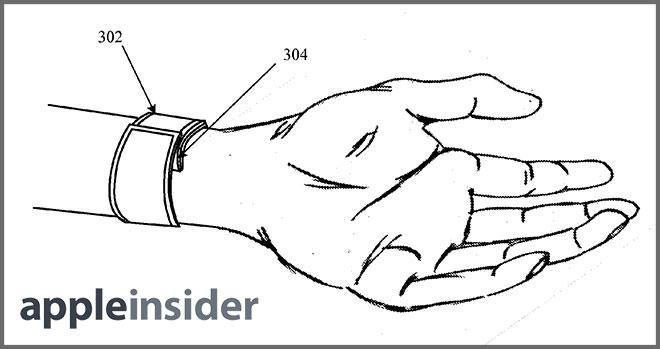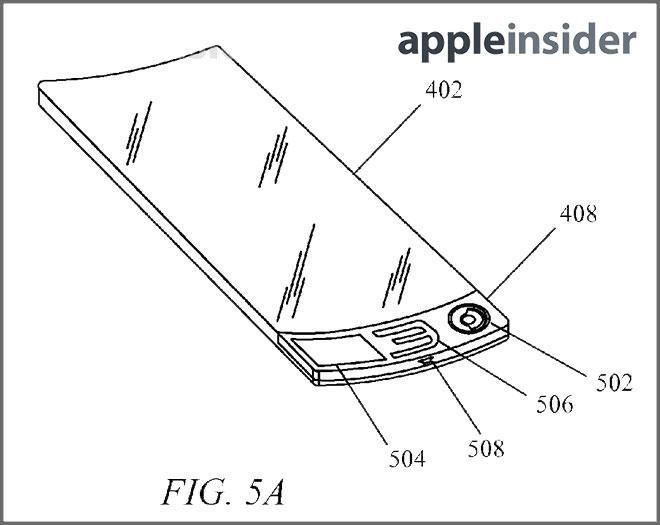A patent application discovered by AppleInsider on Thursday reveals Apple is indeed investigating a wearable accessory device that not only boasts a full-length flexible touchscreen display, but conforms to a user's body through the use of a "slap bracelet" mechanism.
Apple first filed its application for a "Bi-stable spring with flexible display" with the U.S. Patent and Trademark Office in August of 2011, describing a wearable accessory device that can be easily worn on a user's wrist or other body part. When active, the unit connects to a portable device via various communications protocols like Bluetooth or Wi-Fi to show relevant information in real time on a flexible display that can wrap fully around a user's wrist. While the device itself can conform to nearly any appendage, a suitable location would be a user's wrist.
Instead of using clips or other cumbersome methods of attachment, Apple proposes the use of a bi-stable spring:
The most recent widespread use of such a device was the slap bracelet, also called the slap wrap. The slap bracelet consists of layered flexible steel bands sealed within a fabric cover. Typical slap bracelets are roughly one inch in width by nine inches in length. In a first equilibrium position they can be flat. The second equilibrium is typically reached by slapping the flat embodiment across the wrist, at which point the bracelet curls around the wrist and stays relatively secure in a roughly circular position.
According to the filing, in its simplest form, the proposed invention involves embedding a flexible display, along with the necessary electronic components, into a conventional slap bracelet. The bi-stable spring would be made out of thin steel, which would then be wrapped in a fabric covering and heat sealed. The display would be overlaid with an adhesive over one side of the bracelet, while the device's logic board, battery and other parts are mounted to one end. By positioning the components in this manner, the bracelet would cover the vital electronics module when it is being worn.

Source: USPTO
In another embodiment, the invention calls for a more robust design in which the flexible display is mounted directly to the bracelet and "framed" by a thicker, more comfortable fabric covering. Switches and critical electronics should also be resistant to fatigue, the patent notes, as the bracelet switches from a convex shape to a concave configuration depending on whether it is being worn by the user.
When in its "curled state," or otherwise attached to a user's arm, the bracelet can take on the form of an uninterrupted screen. On-board sensors, like gyroscopes and accelerometers, would aid in orienting the screen's information toward the user.

Illustration of device with display (402), kinetic energy gathering device (502),
wireless antennas (506), connector, (508) and battery (504).
While the slap bracelet is the main underpinning discussed, the filing notes that any number of other materials can be used, with mechanisms such as snaps or velcro as used as attachment points. This leaves room for interpretations on the design, including more traditional watch interfaces.
As far as usability is concerned, the invention points out that the accessory doesn't need to be limited displaying information from a portable device like an iPhone, but can also interact with the handset at a basic level:
With a touch screen user input a user can accomplish a number of different tasks including adjusting the order of a current playlist, and reviewing a list of recent phone calls. A response to a current text message can even be managed given a simple virtual keyboard configuration across the face of the flexible display.
Such interactive features are seen in basic form with existing "smart watches" like the Pebble, though Apple's patent extends the idea into more advanced iterations such as the viewing and control of digital maps.
Illustration of continuous display in "curled state."
Apple's wearable display can be a truly universal fit, as an "end-detection" sensor provides a contingency for larger and smaller sized appendages. Located at one end of the device, the sensor can turn off the unused portion of the display that is covered when the bracelet overlaps for smaller users. In some embodiments, the touchscreen itself can be used as the end-detection sensor.
In addition, ambient light energy collectors, commonly referred to as solar panels, as well as kinetic energy gathering devices can be included onto the bracelet to boost battery life. An AMOLED display can further enhance the unit's efficiency, though Apple has yet to deploy a product that uses the technology.
Communications are facilitated through wireless protocols, though the proposed unit also contains wired connectors for syncing and recharging the internal battery.
Cross section views of bracelet.
Thursday's patent application is tangible evidence that Apple is working on a so-called "iWatch." Rumors regarding the purported device have been heating up as many industry watchers say wearable computing is the next logical step for mobile technology.
There are multiple existing patents in Apple's quiver if it decides to build the proposed device, including a manufacturing process for curved glass, solar cell multitouch panels and "shake to charge" kinetic energy technology.
The filing credits Fletcher R. Rothkopf, Derek W. Wright and Scott A. Myers as its inventors.
